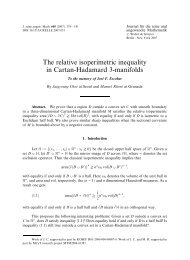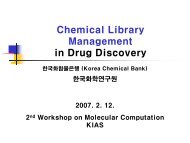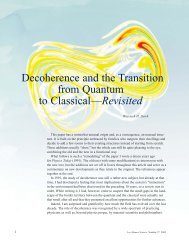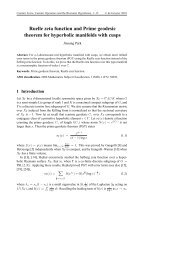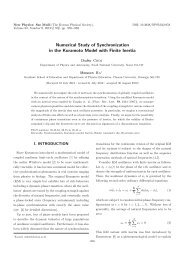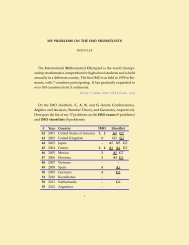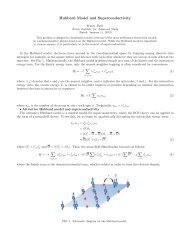A Quantum Kirwan Map: Bubbling and Fredholm Theory for ... - KIAS
A Quantum Kirwan Map: Bubbling and Fredholm Theory for ... - KIAS
A Quantum Kirwan Map: Bubbling and Fredholm Theory for ... - KIAS
Create successful ePaper yourself
Turn your PDF publications into a flip-book with our unique Google optimized e-Paper software.
1.2. SYMPLECTIC VORTICES 3satisfying relations involving the composition maps of V <strong>and</strong> W. Here M n,1 (A)denotes the moduli space of stable n-marked scaled lines. Furthermore, the actionof the symmetric group S n is by permutations of the first n arguments of ψ n . Themap ψ 1 plays the role of ϕ ∗ as in Conjecture 1. The map ψ 0 measures how muchψ 1 fails to be a ring homomorphism. Once proven, Conjecture 2 will give rise toa recursion <strong>for</strong>mula <strong>for</strong> the Gromov-Witten invariants of (M,ω) in terms of theequivariant Gromov-Witten invariants of (M,ω) <strong>and</strong> the morphism (ψ n ) n .The present memoir is part of a project whose goal is to prove Conjectures 1<strong>and</strong> 2. 8 The approach pursued here was suggested by D. A. Salamon. 9 The idea isto construct the maps of the conjectures by counting symplectic vortices over thecomplex plane C. In a first step, we will consider the (symplectically) asphericalcase. This means that∫(1.6)u ∗ ω = 0, ∀u ∈ C ∞ (S 2 ,M).S 2In this case the equivariant quantum cup product is induced by the ordinary cupproduct on HG ∗ (M).1.2. Symplectic vortices, idea of the proof of existence of a quantum<strong>Kirwan</strong> mapTo explain the idea of the proofs of Conjectures 1 <strong>and</strong> 2, we recall the symplecticvortex equations: Let J be an ω-compatible <strong>and</strong> G-invariant almost complexstructure on M, 〈·, ·〉 g an invariant inner product on g, (Σ,j) a Riemann surface,<strong>and</strong> ω Σ a compatible area <strong>for</strong>m on Σ. 10 For every smooth (principal) G-bundle Pover Σ we denote by A(P) the affine space of smooth connection one-<strong>for</strong>ms on P,<strong>and</strong> by CG ∞ (P,M) the set of smooth equivariant maps from P to M. Consider theclass˜B := ˜B Σ := { w := (P,A,u) ∣ ∣ P smooth G-bundle over Σ,(1.7)A ∈ A(P), u ∈ C ∞ G (P,M) } .The symplectic vortex equations are the equations¯∂ J,A (u) = 0,(1.8)(1.9)F A + (µ ◦ u)ω Σ = 0<strong>for</strong> a triple (P,A,u) ∈ ˜B. To explain these conditions, note that the pullback bundleu ∗ TM → P descends to a complex vector bundle (u ∗ TM)/G → Σ. 11 For everyx ∈ M we denote by L x : g → T x M the infinitesimal action, corresponding tothe action of G on M. With this notation, ¯∂ J,A (u) means the complex antilinearpart of d A u := du + L u A, which we think of as a one-<strong>for</strong>m on Σ with values in(u ∗ TM)/G → Σ. In (1.9) we view the curvature F A of A as a two-<strong>for</strong>m on Σ withvalues in the adjoint bundle g P := (P × g)/G → Σ 12 . Furthermore, identifying g ∗with g via 〈·, ·〉 g , we view µ ◦ u as a section of g P . The vortex equations (1.8,1.9)were discovered by K. Cieliebak, A. R. Gaio, <strong>and</strong> D. A. Salamon [CGS], <strong>and</strong>8 Further relevant results will appear elsewhere, including [Zi4, Zi5].9 Private communication.10 This means that j <strong>and</strong> ωΣ determine the same orientation of Σ.11 The complex structure on this bundle is induced by the almost complex structure J.12 Here G acts on g in the adjoint way.



